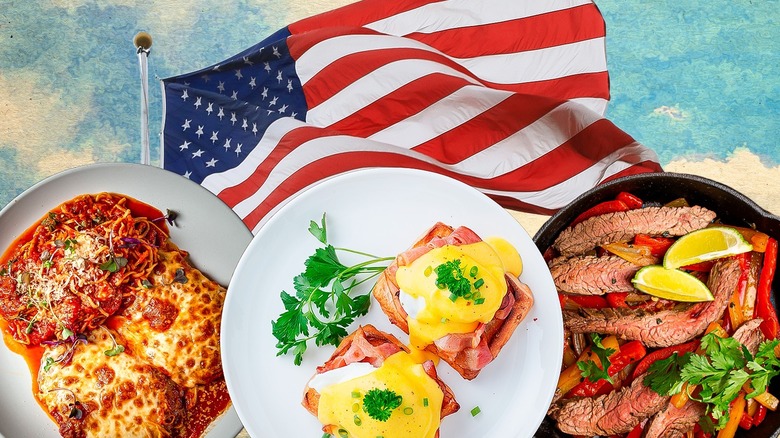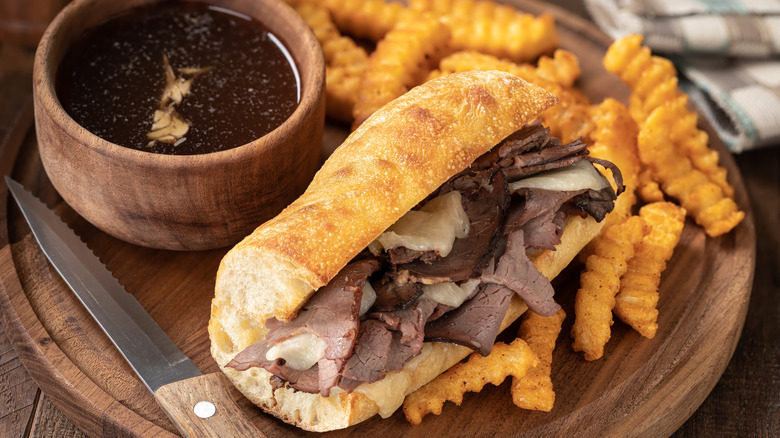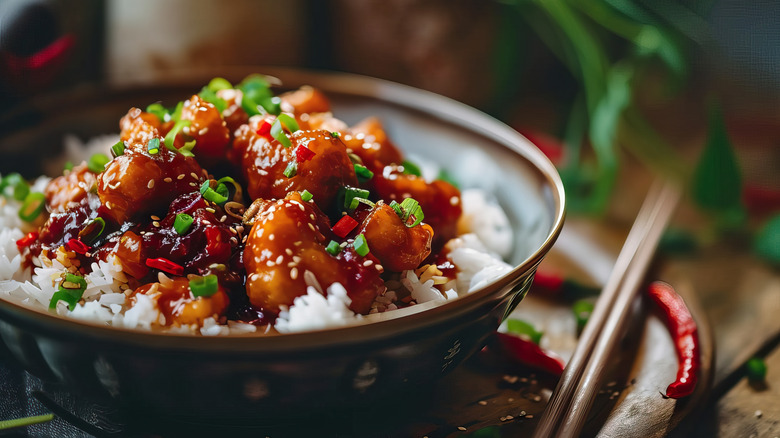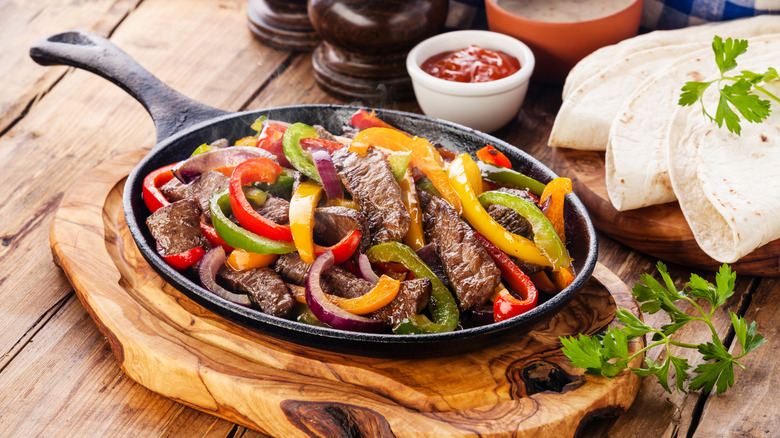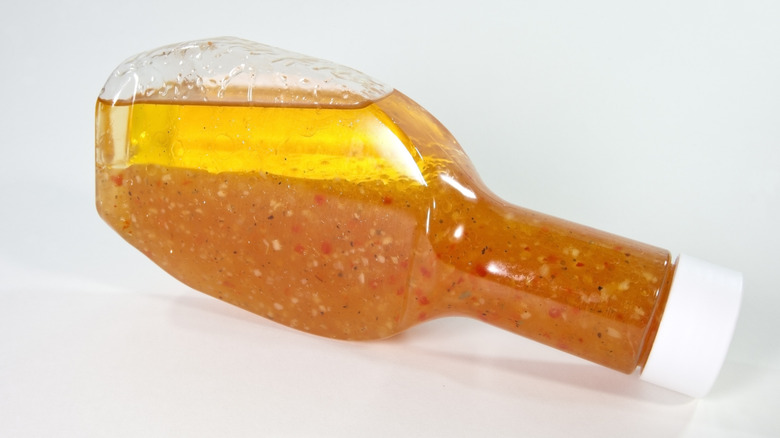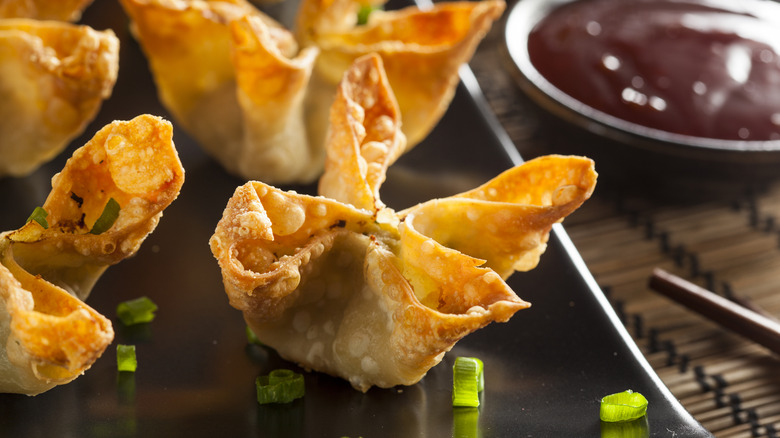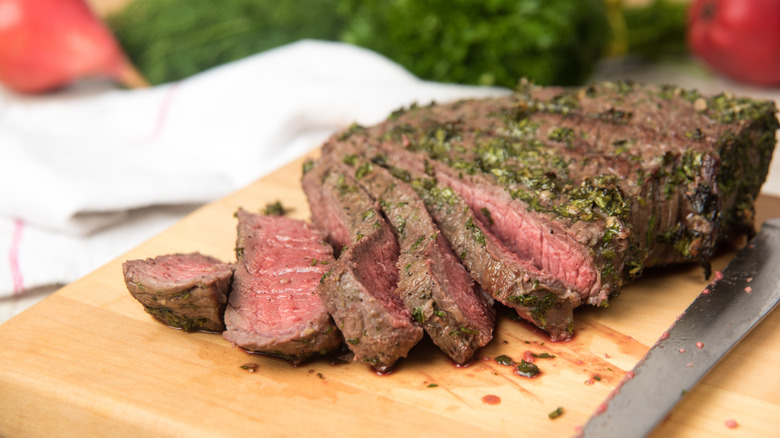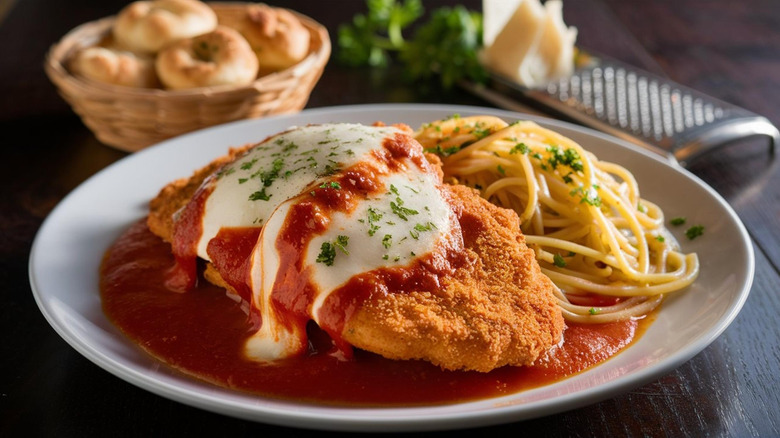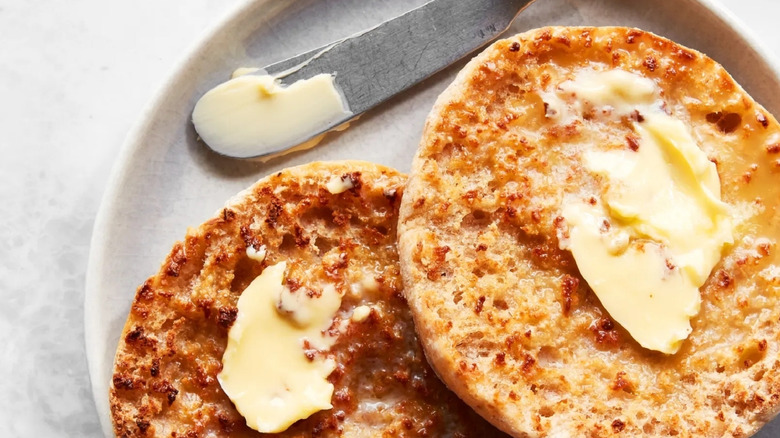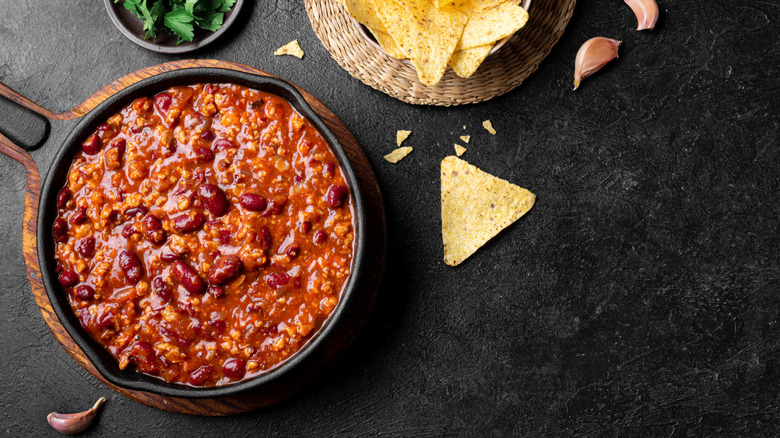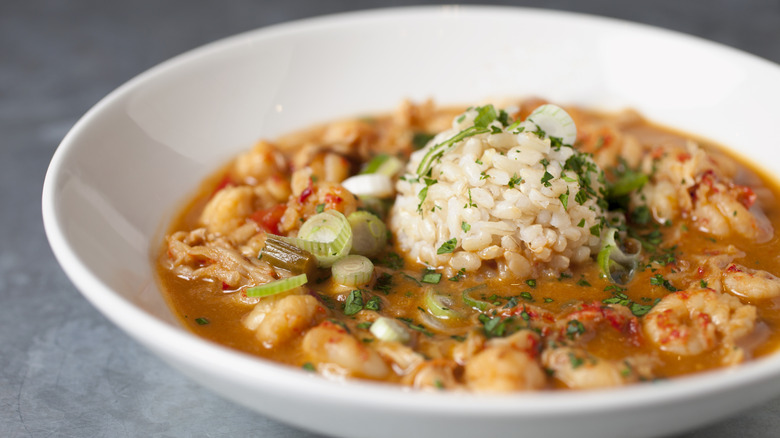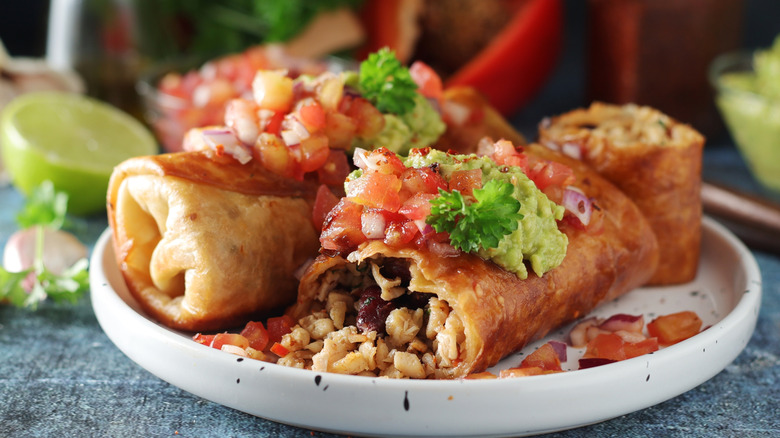13 Iconic Dishes That Were Actually Invented In America
When many people think of classic American foods, they probably think of dishes like hamburgers, hot dogs, and apple pie. Some might go one step further and delve into regional foods across the U.S. like deep-dish pizza, lobster rolls, and gumbo. However, you might be surprised by how many iconic dishes were actually invented in America. There are even some "international" foods that are homegrown creations.
America has long been a melting pot of cultures, and that has had a huge impact on the culinary landscape. Over the years, countless immigrants from around the world brought their culinary traditions with them to America. In some cases, they had to adapt the recipes to the ingredients available and that resulted in a new dish. Then there are the happy accidents where a cooking mishap resulted in something delicious. And, of course, some dishes were created purely out of a spark of inspiration and perhaps a few foreign influences. These are just a few foods that many people assume came from abroad but were actually created in America.
French dip
Don't let the name fool you — the French dip sandwich actually originated in California. Two restaurants in Los Angeles lay claim to being the birthplace of the sandwich, which typically features thinly sliced roast beef in a crusty French roll. The sandwich is either dipped entirely in jus made from the beef drippings or served with jus on the side for dipping. So why is it called a French dip? Only one of the competing restaurants has a plausible explanation.
Philippe The Original states that the sandwich was created by founder Philippe Mathieu in 1918. The story goes that Mathieu was preparing a roast beef sandwich for a police officer when he accidentally dropped the sandwich in the beef drippings. The team at Philippe's speculates that Mathieu could have named the sandwich after his French heritage, the French roll, or the policeman's last name. A competing story comes from Cole's French Dip, which states that chef Jack Garlinghouse created the sandwich in 1908 for a customer who had irritated gums. However, Cole's doesn't offer any reason for why the sandwich was called a French dip.
General Tso's chicken
If you love sweet and sour Chinese dishes, General Tso's chicken is probably right up your alley. The dish consists of battered chunks of chicken in a sticky sauce that's slightly sweet, sour, and spicy. It's named after a Chinese general who was from Hunan province and served in the military during the 19th century. However, the dish did not originate in Hunan province. It was first created in Taiwan and took on its current form in America.
The inventor of General Tso's chicken was a chef named Peng Chang-kuei, who was also born in Hunan province. When the communist party took control of China in 1949, Peng fled to Taiwan and that's where he created the dish. In the 1970s, he migrated to New York and opened a restaurant with General Tso's chicken on the menu. However, Peng told The New York Times the original recipe was not sweet and that he altered the recipe and added sugar to suit American tastes. The new sweet and sour dish was a hit, and it's now a staple at countless Chinese-American restaurants across the country.
Eggs Benedict
It's easy to see why Eggs Benedict is a mainstay of brunch menus worldwide. There's something so satisfying about the combination of luscious poached eggs, salty Canadian bacon, tender English muffins, and creamy hollandaise sauce. It may seem like it's a European creation, but the dish was actually created in New York City in the 19th century. Exactly where it was born and how it got its name is tricky to determine though because there are competing theories about how Eggs Benedict was created.
Once again, we have two restaurants that claim to be the birthplace of this iconic dish. One story is that chef Charles Ranhofer of Delmonico's created the dish for a regular customer who wanted something different. That customer was either Mr. or Mrs. Legrand Benedict. The other claim is that a man named Lemuel Benedict ordered all of the elements of the dish at the Waldorf Hotel after a big night out drinking. Maître d' Oscar Tschirky took notice of the delicious combo and decided to put the dish on the menu. Either way, Eggs Benedict is now an integral part of American culinary history.
Fajitas
When you think of popular Mexican foods, fajitas probably come to mind. You may have had them served at a Mexican restaurant with juicy strips of meat, sauteed peppers, and onions served on a sizzling platter with tortillas and salsa on the side. The truth is that fajitas are one of several Mexican foods that didn't originate in Mexico. They're actually a Tex-Mex creation that came into being around the 1930s.
In the first half of the 20th century, Mexican cowboys working on ranches in Texas were often given tough cuts of meat like flank steak for meals. The cowboys would cook the meat quickly over a fire and eat the strips in tortillas. Fajita translates to "little belt" in Spanish, which alludes to what the meat looked like. It wasn't until 1969 that the dish really took off with a wider audience. According to Texas Monthly, that's when Otilia Garza started serving them on a sizzling platter with an array of condiments at her Round-Up Restaurant in Pharr, Texas. Other restaurants followed suit, and now you'd be hard-pressed to find a Tex-Mex restaurant in the States that doesn't serve fajitas.
Italian dressing
Italian dressing is a bit of a misnomer considering the tangy, herb-flecked condiment was created in America. To be fair though, it does contain several ingredients that are often used in Italian cooking like extra virgin olive oil, red wine vinegar, and herbs like oregano and basil. In addition, the people who created the first Italian salad dressings said the recipes came from their Italian mothers.
You may recognize Wish-Bone Italian dressing from the supermarket aisle. The dressing first made an appearance in 1948 at Phillip Sollomi's Wish-Bone restaurant in Kansas City. The recipe (which Sollomi said was his Sicilian mother's) was so popular that Sollomi started bottling it and eventually sold the restaurant to focus on the salad dressing business.
Around the same time, Ken and Florence Hanna of Ken's Steak House in Framingham, Massachusetts were also earning fame for their salad dressing made from Florence's Italian mother's recipe. They too began to bottle their dressing, and today the company makes over 400 dressings and sauces, including the original Italian dressing that started it all.
Crab rangoon
Crab rangoon may sound like it comes from the Far East, but this deep-fried dish is well and truly an American creation. It typically features imitation crab and cream cheese wrapped in wonton wrappers and deep-fried. It's often served with a sweet and sour dipping sauce on the side. While it's now a common menu item at Chinese-American restaurants, you may be surprised to learn that it originated at a tiki bar.
In 1934, Victor Bergeron opened a bar called Hinky Dink's in Oakland, California. At that time, tiki culture was on the rise in America, so Bergeron adopted an island theme and renamed the spot Trader Vic's. Legend has it that Bergeron created crab rangoon to compliment his menu of Asian and South Pacific-inspired dishes. Eve Bergeron, Victor's granddaughter, told Atlas Obscura that he was probably just playing around with ingredients when he invented the dish.
And the name? Well, the dish has no real connection to Rangoon (now called Yangon), the capital of Myanmar (formerly Burma). Most sources agree it was just an Asian-sounding name that was easy for English speakers to pronounce.
London broil
Peruse the steak on offer at a butcher shop or grocery store and you might come across a cut labeled London broil. Contrary to popular belief, the steak has no connection to London, nor is it even an official cut of steak. London broil actually refers to the way certain cuts of steak are cooked. The term was likely coined in the United States in the early 19th century. No one really knows why it was named after London though.
London broil refers to the process of marinating a tough cut of steak to make it more tender and cooking it quickly with high heat. The most common cut of beef used for a London broil is flank steak, although the cooking method can be used with any tough, lean cut. Broiling is an easy way to blast the meat with high heat, hence the name. However, you can also pan-fry your steak or throw it on the grill. There is no official recipe for the marinade, so cooks are free to get creative with the seasonings.
Chicken Parmesan
Dine at any Italian-American restaurant in the States and there's a pretty good chance you'll find chicken Parmesan on the menu. This indulgent "red-sauce" dish features a breaded and fried chicken cutlet topped with melted mozzarella cheese and tomato sauce. It's often served on top of spaghetti, which adds to its moreishness. Many people associate chicken Parmesan with Italian food, but the truth is you'd be hard-pressed to find this "Italian" dish in Italy.
The origins of chicken parm can be traced back to the Italian diaspora. When Italian immigrants arrived in America, they found that meat was much less expensive than it was in Italy. Therefore, they adapted some vegetable dishes to incorporate meat. Chicken parm is likely a variation of a dish called melanzane alla Parmigiana, which consists of breaded eggplant topped with cheese and tomato sauce. It could also have been influenced by cotoletta alla Milanese, a breaded, fried veal dish. It may be inspired by Italian dishes, but the crunchy, cheesy, tomato sauce-laden dish we know today is an Italian-American creation.
English muffins
English muffins may just be the perfect bakery product. Crunchy on the outside, soft on the inside, they're divine when toasted and eaten with butter pooling into those nooks and crannies. There are also so many uses for English muffins. You can use them as a base for Eggs Benedict, turn them into a grilled cheese sandwich, or tear them up for a panzanella salad. So, who do we have to thank for their creation? That would be Samuel Bath Thomas, a British-born baker who created them in his New York bakery.
Thomas moved to New York at the end of the 19th century and opened a bakery in Chelsea where he invented English muffins. He took inspiration from crumpets but used a unique griddle method to create pockets of air inside the muffins and a coarse, grainy exterior. Thomas also split the muffins instead of slicing them to give them the perfect texture for toasting. The muffins were a huge hit, so much so that they eventually made their way across the ocean to the U.K. However, there they're simply called "muffins" or "American muffins."
Chile con carne
Chile con carne's Spanish name may lead you to believe it originated in Mexico. By all accounts though, this meaty concoction falls under the umbrella of Tex-Mex cuisine. In fact, many say this dish featuring stewed meat, chilies, tomatoes, and spices was one of the first Tex-Mex creations. Who created chili con carne and exactly when are debated, although many food historians agree that the dish has its roots in San Antonio, Texas.
Texas Monthly reports that chile con carne may have been created by Spanish immigrants from the Canary Islands who settled in San Antonio in the 1700s and introduced a spicy stew similar to chili. Others say the dish was created by Texas cowboys who pounded dried meat, chili peppers, and spices together into bricks that they could carry on their travels and reheat with water. Yet others say the "Chili Queens," who sold the dish at the San Antonio Military Plaza in the mid-1800s were the creators. Whoever invented it, chili took a firm hold in Texas, eventually becoming the official state dish.
Étouffée
If we've learned anything from many of the foods on this list, it's that names can be deceiving. Such is the case with the French-sounding étouffée. This hearty dish features shellfish like shrimp, crawfish, or crab simmered in a roux that creates a rich gravy. It's often served with rice. The name comes from a French word meaning "smothered." However, this savory seafood dish did not originate in France. It was born in Louisiana and is intricately linked to Cajun and Creole cuisine.
New Orleans Magazine reports that étouffée was first created at the Herbert Hotel in the 1920s. The recipe was passed along to Aline Champagne, who went on to sell it at the Rendezvous Restaurant in Breaux Bridge, which is where the dish became famous. Today, you can find multiple variations of the dish that incorporate different ingredients like tomatoes and various herbs and spices. You can expect some elements to remain the same though like the shellfish, creamy gravy, and vegetable base featuring the "holy trinity" of Cajun and Creole cooking: onion, celery, and bell peppers.
Chop suey
When many people think of chop suey, they think of Chinese cuisine. The truth is, the origins of this dish of stir-fried meat and veggies are as murky as the sauce it's tossed in. While it may have had its roots in China, the dish probably wasn't anything like the version you get from your favorite Chinese takeout spot. In addition, it likely never received the widespread popularity there that it did in America.
The Association for Asian Studies reports that chop suey is probably a variation of a stew from South China called zacui or zaptsui (also transliterated as tsa sui or tsap seui). The name of the stew translates roughly to "a varied mix," referring to the medley of random meat and vegetables. When Chinese workers began migrating to California to work in the gold mines in the 1800s, they likely adapted the dish to whatever ingredients were on hand. Chop suey quickly took off in America, spreading across the country and even becoming synonymous with Chinese cuisine. While its popularity has waned somewhat over the past few decades, it's still considered an icon of Chinese-American cuisine.
Chimichangas
Chimichangas are essentially deep-fried burritos, but that doesn't mean they were created in Mexico. These crispy stuffed treats were actually born in Tucson, Arizona. The ingredients vary, but they typically include meat, rice, beans, and cheese wrapped in a flour tortilla and deep-fried. The origin story of chimichangas is hard to pin down because here we have another case where multiple restaurants take credit for inventing the dish.
The most compelling argument for the birth of the chimichanga is that it was created at El Charro Cafe in 1922 when owner Monica Flin dropped a burrito in the deep fryer by accident. She wanted to use a Spanish curse word but changed it to "chimichanga" because there were children around. Another possibility is that Woody Johnson of Macayo's Mexican food invented the chimichanga, also by accidentally dropping a burrito in the deep fryer. It should be noted that several other restaurants lay claim to the dish's invention. All we know for sure is chimichangas were created somewhere in Tucson in the 20th century.
